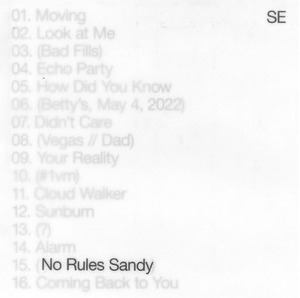ALBUM REVIEW: No Rules Sandy by Sylvan Esso
Follow WHIP Twitter Facebook Instagram
WRITTEN BY: John Peterson
In a summer filled with high-profile dance albums (*cough cough* Drake, Beyoncé, ODESZA), I fear that Sylvan Esso may have slipped under the radar. If you haven’t tuned in to the electronic pop duo since their self-titled grand entrance, consider paying them a visit. Their latest album, No Rules Sandy (released August 12, 2022), makes a case for being their best yet.
Perhaps Sylvan Esso will never be able to recreate the transient timelessness of 2014’s “Coffee”—lullaby-like in its cradling atmosphere and honest intimacy—but moments aren’t meant to be replicated. Recording No Rules Sandy over the course of just three weeks, singer Amelia Meath and producer Nick Sanborn embrace impermanence, hopping from one moment to the next without overthinking. The result is an album that refuses to sit still filled with songs that are equally restless.
As an opener, “Moving” acts as a sort of prelude, reintroducing the band’s philosophy and music. Meath’s delicate voice is an oasis of calm in a desert of commotion, singing, “How can I be moved when everything is moving?” And everything does move, swirling beautifully around and around until it becomes a new resting point. Sanborn has diversified his sound design to match the mood, constructing deceptively basic synths that should probably be trademarked. He expands on his at-times minimalist production with more involved soundscapes. No matter how chaotic the songs of No Rules Sandy get, however, they never feel crowded, each element in its proper place and impressively soft on the ears.
Amid the patters, buzzes, and crashes of No Rules Sandy, it’s hard to imagine how to insert a singer. With her simple melodies and abstract lyrics, Amelia Meath is the perfect fit, stabilizing whatever Sanborn throws at her. As the drumless second single, “Your Reality” never breaks into the cathartic dance you expect. Mixing real strings with synths that emulate their pizzicato, Sanborn creates a beautifully tense environment that Meath navigates with ease. Void of a drop, the tension is released instead by the chorus, as Meath repeats, “Surreal but free/It’s your reality.”
As with any good electronic producer, Sanborn takes pleasure in the unpredictability of an offbeat. If the music of Sylvan Esso showed an appreciation for syncopation, songs like “Sunburn” and “Echo Party” are a full-fledged obsession. The latter track takes inspiration from house music, pitting rhythms against each other until you’re obliged to feel each attack as part of a whole. With some awkward breaks, “Echo Party” might not appear alongside Drake’s “Massive” in the club, but it does give a taste of what house can offer the indie world.
Speaking of awkward breaks, of the album’s 16 tracks and 35-minute runtime, six tracks are “(Bad Fills).” Although the interludes provide a warm lo-fi touch, their recurrence breaks the flow of the album one (or six) too many times. In the name of spontaneity, it’s understandable why Sylvan Esso might want to include the collection of half-formed soundscapes and familial voice notes, but realistically, at least half should have been left on the cutting room floor.
From the addictive, Giorgio Moroder-esque synth bass of “Alarm” to the hyperpoppy bike bells and detuned synths of “Sunburn,” No Rules Sandy’s impulsivity covers a variety of electronic music. For the album’s conclusion, however, Amelia Meath turns to her folk roots and delivers a powerful ballad. The singular acoustic track in the electronic catalog of Sylvan Esso, “Coming Back to You” nonetheless unites their entire body of work. Continuing the surreal themes of No Rules Sandy, Meath reflects, “I’m eighty-five/I’m sixteen/I am a mother/a baby.” In short, she’s a mirror-image of her album, an inimitable moment that can’t be repeated but can’t be forgotten.




